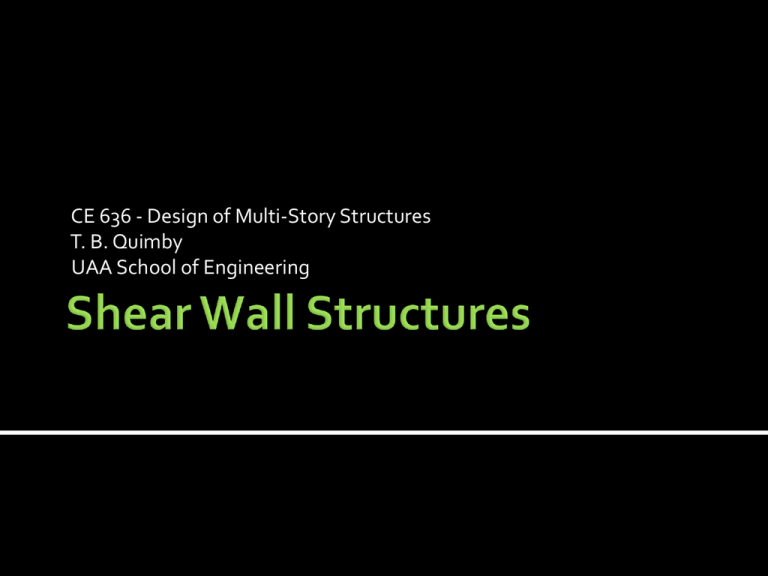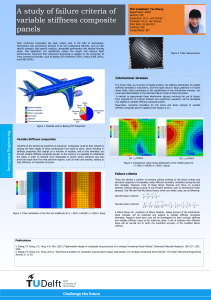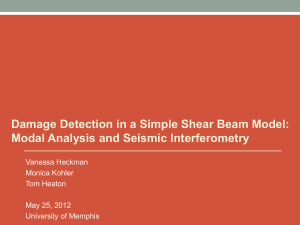Introduction to Lateral Force Resisting Systems
advertisement

CE 636 - Design of Multi-Story Structures T. B. Quimby UAA School of Engineering Behave as tall cantilever beams. Deflection is predominately in flexure. The wall elements have high shear stiffness, mainly because the “beam” element has a depth that is large compared to it's span (level to level). Economical for buildings up to 35 stories. The walls can also be used to resist gravity forces. Proportionate: Walls, at each level, maintain their relative rigidities through out the height There is no redistribution of overturning moments or shears at any level. Nonproportionate: The relative rigidities of the walls changes from level to level. There is a redistribution of overturning moments and shears at one or more levels. All walls deflect the same when there is no twist. Twisting takes place about the center of rigidity Each wall on a given floor takes the Story Shear in proportion to their relative rigidities. The author uses the bending stiffness of each pier to determine the relative stiffness (see section 9.2 of the text). Our text considers walls to be without openings, which is generally true for tall buildings, but not necessarily so for short buildings. Openings in walls must be considered when computing relative stiffness. “Reinforced Masonry Engineering Handbook” (by James Amrhein, published by the Masonry Institute of America) has an excellent treatment of shear wall analysis for low rise buildings. Piers are viewed as being fixed against rotation at both ends (fixed-fixed) or at one end only (cantilevered, fixed-pinned). Stiffness = 1/(deflection resulting from a unit load) Amrhein's equations for deflection consider both flexural and shear deflections. Author's equation only considers flexural contribution to stiffness and considers only cantilever beam action, OK for tall buildings that have shear walls w/o openings. See Amrhein's book, Table T-1i, for stiffness calculation including shear deformation effects and for different end fixity conditions. Need to determine the deflection of the wall under a unit load, then invert it. Divide wall into individual piers and add up deflections. Subdivide into piers Find deflection of each vertical subdivision and add together All piers in a given vertical subdivision must deflect the same. The stiffness of a vertical subdivision is the sum of the stiffnesses of the individual piers. Deflection = 1/stiffness Create five piers Use Amrhein's formulas for Fixed-Fixed piers. The stiffness is the force that will cause a unit deflection in the pier. Pier A B C D E h 10 4 4 6 10 d 60 16 10 46 4 deflect. 0.0505 0.0766 0.1264 0.0394 2.3125 stiffness 19.82 13.06 7.91 25.41 0.43 deflection A = deflection BCDE = 0.0505 ? Determine the deflection of Piers B & C under a unit load. Stiffness of B 13.06 Stiffness of C 7.91 Stiffness of BC 20.97 deflection BC for F(BC) = 1 0.0477 Add deflection of BC to deflection of D to get deflection BCD, then invert to find the stiffness of BCD deflection D for F(BC) = 1 deflection BCD for F(BC) = 1 Stiffness of BCD 0.0394 0.0870 11.49 Add deflections of A and BCDE to get total deflection of the wall under a unit wall. Then invert the deflection to determine the stiffness of the wall. Deflection ABCDE Stiffness ABCDE 0.1343 7.44 It is interesting to compare this to the stiffness of the wall without the openings h solid wall 20 with openings d 60 defl. 0.104 0.134 stiffness 9.643 7.444 22.80% reduction For design, you will need to know how much shear force is on each of the piers so that you can draw a free body diagram to determine the moments on the piers and then design for the shear and moments. Pier A will see 100% of the force The full force will be divided between piers BCD and E in porportion to their stiffnesses. BCD E Stiffness % Load 11.490 96.37% 0.432 3.63% 11.922 Pier D will see all of the load on BCD, or 96.37% of the total wall shear This same load is divided between piers B and C in porportion to their stiffnesses. B C Stiffness % BCD % Load 13.06 62.28% 60.02% 7.91 37.72% 36.35% 20.97 100.00% 96.37% Flexible diaphragms cannot transfer moment. Flexible diaphragms are considered to act as simply supported beams between shear wall support. Normally wood or steel decking w/o concrete. Loads are distributed to walls according to tributary loads. Story shear and Story Moment is distributed to each wall according to relative stiffnesses. Determine location of center of rigidity and center of force to determine any eccentricity. Story moment equals the story shear times the distance between the centers of force and rigidity. Determine the Center of Stiffness Wall 1 2 3 A B Totals h 10 10 10 10 10 Center of Rigidity Center of Force Eccentricities d 30 20 30 40 60 Kx 9.64 6.15 9.64 25.44 x 27.58 30.00 2.42 y 11.92 15.00 3.08 Ky 13.06 19.82 32.88 x 0 20 60 y Kx*x 0.00 123.08 578.57 30 0 701.65 Ky*y 391.84 0.00 391.84 Let Qx = M = Qx*y = 1.00 -3.08 Distribution of just the story shear, Q Wall(j) 1 2 3 A B Totals Ky 13.06 19.82 32.88 Q(j) 0.000 0.000 0.000 -0.397 -0.603 -1.000 Distribution of just the moment, Qx*y Wall(j) 1 2 3 A B Totals Wall(j) 1 2 3 A B Totals Kx Ky 9.64 6.15 9.64 x 0 20 60 13.06122 19.81651 y 30 0 c 27.58 7.58 -32.42 18.08 -11.92 25.44 Kc 265.96 46.65 -312.61 236.17 -236.17 Kcc Kc/s(Kcc) 7335.43 0.0107 353.67 0.0019 10134.57 -0.0126 4270.48 0.0095 2814.71 -0.0095 24908.86 Qe(j) -0.0329 -0.0058 0.0387 -0.0000 Qe(j) -0.0292 0.0292 0.0000 Check -0.9076 -0.0438 -1.2540 -0.5284 -0.3483 -3.0820 Wall(j) 1 2 3 A B Totals Q(j) 0.000 0.000 0.000 -0.397 -0.603 -1.000 Qe(j) -0.033 -0.006 0.039 -0.029 0.029 -0.000 Total -0.033 -0.006 0.039 -0.426 -0.574 -1.000 Let Qy = M = Qy*x = 1.00 2.42 Distribution of just the story shear, Q Wall(j) 1 2 3 A B Totals Kx 9.64 6.15 9.64 25.44 Q(j) -0.379 -0.242 -0.379 0.000 0.000 -1.000 Distribution of just the moment, Qy*x Use same distribution as for Qx*y Wall(j) 1 2 3 A B Totals Kc/s(Kcc) 0.0107 0.0019 -0.0126 0.0095 -0.0095 Qe(j) 0.0258 0.0045 -0.0304 0.0000 Qe(j) 0.0229 -0.0229 -0.0000 Check 0.7124 0.0343 0.9842 0.4147 0.2733 2.4190 Wall(j) 1 2 3 A B Totals Q(j) -0.379 -0.242 -0.379 0.000 0.000 -1.000 Qe(j) 0.026 0.005 -0.030 0.023 -0.023 0.000 Total -0.353 -0.237 -0.409 0.023 -0.023 -1.000 Wall(j) 1 2 3 A B Totals Qx -0.033 -0.006 0.039 -0.426 -0.574 -1.000 Qy Control -0.353 -0.353 -0.237 -0.237 -0.409 -0.409 0.023 -0.426 -0.023 -0.574 -1.000 Best solved by appropriate computer modeling. The author presents a method similar to moment distribution to deal with nonproportionate nontwisting structures. We will not cover it. If twisting is a factor, then the problem is too complex for hand solutions. There is redistribution of moments and shears at levels where changes occur. Levels adjacent to change levels also participate in the redistribution. Take some time to model a disproportionate system or two and explore the effects on shear and moment distributions.






![[K] m - Dr.A.Shah](http://s2.studylib.net/store/data/005723867_1-dbc716a011e78f142a29df801733e2a7-300x300.png)